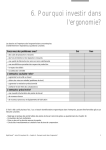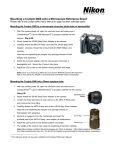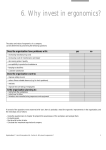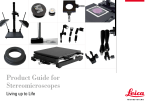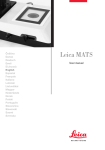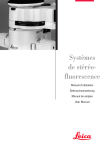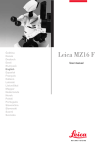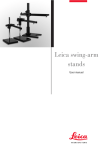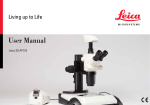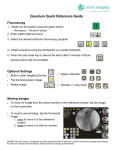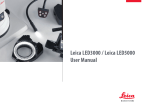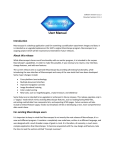Download user_manual_motorfok
Transcript
Leica Motor-Focus System User manual Manuel d’utilisation Gebrauchsanweisung Manual de empleo Contents Description . . . . . . . . . . . . . . . . . . . . . . . . . . . . . . . . . . . . . . . . . . . . . . . . . . . . . . . . . . . . . . 4 Safety concept . . . . . . . . . . . . . . . . . . . . . . . . . . . . . . . . . . . . . . . . . . . . . . . . . . . . . . . . . . 4 Overview . . . . . . . . . . . . . . . . . . . . . . . . . . . . . . . . . . . . . . . . . . . . . . . . . . . . . . . . . . . . . . . . 6 Assembly The components . . . . . . . . . . . . . . . . . . . . . . . . . . . . . . . . . . . . . . . . . . . . . . . . . . . . . . . . . 7 Assembly . . . . . . . . . . . . . . . . . . . . . . . . . . . . . . . . . . . . . . . . . . . . . . . . . . . . . . . . . . . . . . . 8 Use Switching on and off . . . . . . . . . . . . . . . . . . . . . . . . . . . . . . . . . . . . . . . . . . . . . . . . . . . . . . 9 Acoustic signal . . . . . . . . . . . . . . . . . . . . . . . . . . . . . . . . . . . . . . . . . . . . . . . . . . . . . . . . . . 9 Stops . . . . . . . . . . . . . . . . . . . . . . . . . . . . . . . . . . . . . . . . . . . . . . . . . . . . . . . . . . . . . . . . . . . 9 Footswitch . . . . . . . . . . . . . . . . . . . . . . . . . . . . . . . . . . . . . . . . . . . . . . . . . . . . . . . . . . . . . . 9 Handswitch . . . . . . . . . . . . . . . . . . . . . . . . . . . . . . . . . . . . . . . . . . . . . . . . . . . . . . . . . . . . 10 The focusing position: Storing, travelling, cancelling . . . . . . . . . . . . . . . . . . . . . . . . . 10 Focusing with the PC . . . . . . . . . . . . . . . . . . . . . . . . . . . . . . . . . . . . . . . . . . . . . . . . . . . . 10 EN 3 Description Safety concept Purpose Before you try to set up and use the motor-focus system, read: The purpose of the motor-focus system is to provide motordriven coarse and fine focusing by means of a manual control, a footswitch, or through a computer. Five exact focus settings can be stored so that the instrument can travel to them directly. The motor-focus system offers the following advantages over manual focusing: • this user manual, and in particular the safety notes • the user manual for your stereomicroscope or macroscope, including the notes about safety and care. • Easy to use, even with heavy outfits • Ergonomically better • More flexibility for the user • Leaves the hands free • Saves time during repetitive tasks. The motor-focus system is intended for the motor-driven raising and lowering of the LEICA MS5, MZ6, MZ8, MZ12, MZAPO and MZ FLIII stereomicroscopes and of the LEICA M420 macroscope on Leica incident- and transmitted-light stands, and on the large swinging-arm stand, and it replaces the mechanical drive housing. The motor-focus system consists of Permitted uses • a column with motor-focus mechanism For Leica stereomicroscopes • a transformer with a power cable The modular design of the motor-focus system enables it to be fitted to the incident- and transmitted-light stands and large swinging-arm stand of the LEICA MS5, MZ6, MZ8, MZ12, MZAPO and MZ FLIII stereomicroscopes and of the LEICA M420 macroscope. • a manual control and/or a footswitch and/or a PC interface kit. User manual Prohibited uses The use of the motor-focus system in a different manner from that described in this user manual can lead to injury, malfunction and damage. The present user manual describes the design and use of the motor-focus system. There is a separate user manual for the stereomicroscope or macroscope. • Do not fit different plugs. • Do not attempt to modify the motor-focus system. • Do not dismantle any part of the motor-focus system unless instructions for doing so are given in the user manual. For safety directions, and for detailed information about the stereomicroscope or macroscope and how to clean it, and about its stands, illuminators and accessories, please refer to the user manual for that instrument. • Do not allow the motor-focus system to be opened by unauthorized personnel. Place of use The motor-focus system is intended for use only in closed rooms. Responsibilities of person in charge of instrument 4 • Ensure that the motor-focus system is operated, maintained and repaired only by authorized and trained personnel. • Ensure that personnel who use the motor-focus system have read and understood this user manual and in particular all safety instructions. Safety regulations Power cable • Inspect the power cable regularly for damage. If it is defective, replace it immediately, because it can cause the instrument and ancillary equipment to become electrically live, endangering personnel. Do not pull at the power cable. • Position the power cable carefully and make sure that no-one can become entangled in it or fall over it. Repairs and servicing • Only Leica-trained service technicians, or technical specialists assigned by the person in charge of the instrument, are permitted to carry out repairs. • Only original Leica spare parts may be used. • Disconnect the power cable before opening the transformer, otherwise there is a risk of injury through electric shock. Cleaning • Disconnect the power cable before you attempt to clean the motor-focus system. • Respect the warning signs relating to the handling of liquids. • Read and follow the notes about cleaning which are given in the user manual for the instrument. Precautions by the manufacturer • The motor-focus system is electromagnetically compatible in accordance with the directive 89/336/EEC and can be operated at the same time as other electrical appliances. • Low-voltage protection prevents electric shock if the circuit inside the motor housing is touched. • Stops on the column, and end-switches on the motor housing, limit the upward and downward movement of the motor-focus system. The end-switches prevent it from attempting to travel further when it encounters the stops. Warning: Danger of crushing and other injuries When focusing, keep your fingers away from: • the space between the motor housing and the lower stop • the space between the objective and the object, the surface of the stand, the stage insert and the stage. Precautions by the manufacturer: The lower stop must be adjusted individually in accordance with the characteristics of the object (see below). EN Liquids Be careful when handling liquids. If spilt on electrical appliances, they can: • cause the instruments and accessories to become electrically live, endangering personnel • cause damage to the equipment. Legal requirements Adhere to general and local regulations relating to accident prevention and environmental protection. Conformity with European Community directive The motor-focus system and its accessories are constructed in accordance with the latest technologies and are provided with a statement of conformity with EC requirements. Safety note Always set the lower stop correctly in relation to the object (see page 9). If it is set too low: • the user’s hands might get crushed between the objective and the object • the object might get flattened or otherwise damaged • the objective might get damaged. 5 Overview 2 1 3 5 4 Components Motor-focus system on incident- or transmitted-light stand 1 Stereomicroscope 2 Stand with column and motor-focus system 3 Transformer 4 Handswitch 7 5 Footswitch 6 Standard PC (not illustrated) Motor-focus system on large swinging-arm stand 7 Inclinable carrier rod with motor focus 6 Assembly 2b 5 EN 4 3 1a 3 8 7 1b 2a The components 4 Microscope carrier 1a 300mm-long column with motor-focus mechanism 5 Optics carrier 1b Inclinable carrier rod with motor focus 6 Transformer (not illustrated) 2a Incident- or transmitted-light stand 7 Handswitch 2b Large swinging-arm stand 8 Footswitch 3 Lower stop 9 PC interface kit (not illustrated) 7 Assembly Connecting the motor focus Incident- or transmitted-light stand Column with motor-focus mechanism ➜ base of stand Using three Allen screws, secure the column to the incident- or transmitted-light base (refer to user manual for stereomicroscope or macroscope). Using the clamping screw, secure the lower stop to the column, taking the position of the object into account (see page 9). 1 Large swinging-arm stand 2 Fit the inclinable carrier rod to the horizontal arm in accordance with the user manual for the stereomicroscope or macroscope. 3 Using the clamping screw, secure the lower stop to the carrier rod (see page 9). Microscope carrier ➜ column with motor-focus mechanism Using an Allen screw, secure the microscope carrier to the column of the stand (refer to user manual for stereomicroscope or macroscope). 1 Connector for transformer 2 Connector for footswitch or for PC interface kit 3 Connector for manual control Fit the optics carrier, binocular tube and accessories to the stereomicroscope or macroscope in accordance with the user manual. Transformer Respect the directions for safety on pages 4 and 5. Technical data Type MST31 Input voltage Input frequency Input current 85 to 264 VAC 47 to 440 Hz max. 0.80 A at 115 VAC max. 0.50 A at 230 VAC Operating voltage 30V Operating temperature +10°C to +40°C Storage temperature –20°C to +55°C Maximum mechanical loading 12 kg 8 Connect the transformer to the motor-focus mechanism. Connect the power cable to the electricity supply. Connect the manual control and/or footswitch. If appropriate, connect the PC interface kit instead of the footswitch. Use Safety measures for the stops Read the warnings on page 5. • The fixed stop (5) on the upper part of the column, and the adjustable stop (6) beneath the motor housing, limit the movement of the motor-focus system. • In addition, there is an end-switch (7) on top of the motor housing and another one beneath it. If, during focusing, an end-switch touches the stop, there is a series of beeps and the movement ceases. 5 7 4 Set the lower stop • so that your hands have enough room between the objective and the object, even when the motor-focus system has reached the stop • so that during focusing the objective cannot press against the object and damage either objective or object. EN Place the object beneath the objective. Look into the eyepiece and carefully bring the object into 6 8 focus using the manual control (see page 10), the footswitch or the PC (see page 10). Use the clamping screw (8) to secure the lower stop beneath the motor housing. Focusing Footswitch Switching on and off Switch on the motor-focus system (switch 4). • Confirmation by acoustic signal. Acoustic signal There is an acoustic signal when: • the system is switched on (one short beep) • there is a changeover between coarse and fine focusing (one short beep) • the focus position is stored (two short beeps) • the focus position is cancelled (two short beeps, pause, two long beeps) • the stop is reached (series of beeps) 16 15 To switch off the acoustic signal When switching on the system, press switch 11 or 12 on the manual control (see page 10), or activate the footswitch. • To focus using the footswitch: Left-hand switch (15) = up; right-hand switch (16) = down. • To change between fast- and fine focusing: Press left-hand and right-hand switches at the same time. • Focus positions cannot be stored by means of the footswitch. 9 Handswitch Storing the focus position 11 12 10 • Focus positions can be stored only by means of the manual control or the PC. • A maximum of five focus positions can be stored. • If a sixth focus position is stored, the one nearest to it will be cancelled. • Each focus position can be cancelled individually. • The system will travel to each of the individual focus positions in the sequence in which they were stored. • Switching off the system cancels all of the stored focus positions. Place the object beneath the objective. Set the lower stop (see page 9). Focus on the first point in the object. Press the black switch (12) for at least 1.5 seconds. 10 Rotary knob for focusing 11 Red switch for alternating between coarse and fine focusing 12 Black switch for storing or cancelling up to five focus positions and for travelling to the stored positions The storage is confirmed by two short beeps. Focus on the second point in the object and store in the same way. Focus and store up to five points in the object. Travel to the stored focus positions Focusing with manual control Briefly press the black switch (12). Respect the safety notes on pages 4 and 5. • Focus with the red rotary knob (10): Anticlockwise = down; clockwise = up. • Change between coarse (rapid) focusing and fine focusing by briefly pressing the red switch (11). • When the system is first switched on, the rapid focusing mode is active. 10 To cancel the focus positions Keep the black switch (12) pressed until you hear two short beeps, a pause, and two long beeps. Focusing with the PC • In addition to a standard PC with RS232 interface, you need a PC interface kit from Leica. • The individual functions and commands are described in a separate user manual for the PC interface kit.









